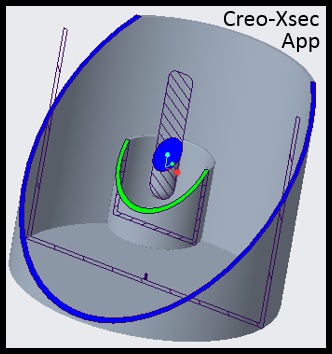CAD-Link
Creo
Creo Parametric cross section application for Elfi2d
Elfi2d includes a cross section application (Creo-Xsec-App) that can extract a fully defined data set from a Creo cross section created and selected by the user. This application can be started either from Elfi2d or from a Creo session which uses a standard Creo Parametric license (Creo Simulate license is not required). The Creo-Xsec-App connects to a Creo session running on same computer and reads the geometry as well as all other characteristics of the current Creo model. The material properties like permittivity and electrical conductivity can be defined as customized material properties whereas boundary conditions like potential or floating potential are assigned to parts as parameters. Details of the Creo-Xsec-App are presented in the Elfi-Creo manual included in the Elfi installation pack.
Creo Simulate for Elfi3d
The main advantage of Creo Simulate is enabling the 3D simulation. However, an enhanced Creo Premium license is needed, which includes an access to the linear structural mechanics module (in contrast to the standard Creo Parametric package a license fee may be required for Creo Simulate even for the educational use). We use the structural mechanics module to define an electrostatic model since no electromagnetic module is available in Creo Simulate. For that reason the electric potentials in the model nodes must be defined as "structural temperatures". The boundary element mesh consisting of 3D parabolic triangles is created directly in Creo Simulation for the same geometrical parts that are used by Elfi2d. The boundary conditions and the material properties are defined in Creo Simulation. They need to be synchronized with the values defined for Elfi2d by the user. They cannot be extracted from Creo Simulation for 2D computations due to PTC licensing limitations of the educational software version. The mesh control tools as well as viewing and evaluation of basic results are included in the Creo Simulation. The visualization of results can be alternatively performed in ParaView. See Elfi-Creo manual for more details on Elfi3d.Solid Works
The Solid Works is currently used only to create Elfi3d models, which can be done via the static, linear mechanics module. Similar to Creo an electromagnetic module is not available in the standard Solid Works packages. Therefore, mechanical properties like structural temperature and elacticity modulus are used as placeholders for electric potentials and relative permittivity, respectively. The user can generate in Solid Works an equivalent "mechanical" model based on parabolic tetrahedral mesh and export it to a file written in Cosmos format (file extension .geo). The Cosmos file format can be read directly as an input file into Elfi3d, converted to an electrostatic boundary element model (BEM) and computed by a BEM-solver like Casopt. A usable set of boundary elements cannot be created directly in Solid Works but in contrast to electromagnetic implementations of finite element method (FEM) the generation of volume mesh can be limited to the volume inside of solid parts (without outer space). Vieweing and evaluating results of Solid Works models can be done only in ParaView. Loading results back into the Solid Works is not implemented.
FreeCAD
FreeCAD is an open-source parametric 3D modeler. In contrast to Creo and SolidWorks no license for both educational and commercial usage is required. Additional advantage of FreeCAD is its availability on Linux. Currently, the interface between FreeCAD and Elfi is under development. It is planned to operate this interface as a plugin to the Elfi package.